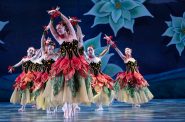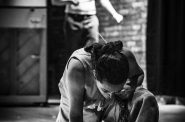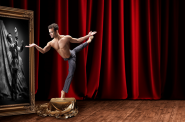Spring moderns
An ambiguous gloom permeates Alejandro Cerrudo’s Extremely Close, one of three newer works the Milwaukee Ballet danced Thursday night.
Feathery white bits wafted down from the flies and gradually covered the stage as we re-entered Uihlein Hall after intermission. The whitened floor contrasted sharply with the black curtains. Three large white squares wheeled on; Alexandre Ferreira, shirtless beneath a black business suit bursts from behind one of them into a wheeling, tumbling passage. I thought: 9/11?
Maybe. The particulars are vague, but the elegiac tone is clear. The eight dancers keep their focus inward, no matter how fleet their travels or how recklessly they slide through the feathery stuff. Much of the movement, most notably a remarkable scuttling solo by Marc Petrocci, is low. Minimalist piano music by Philip Glass and Dustin O’Halloran (hard to tell them apart, frankly) maintains a uniform tension that is never released, and the dance reflects that.
The closer contact of Ferreira and Nicole Teague in the closing duet brings a hint of passion. But even that is cool, resigned, ceremonious. Only at the very end do they give us an explicit reason to grieve.
Lila York’s Celts, revived here after several years, mixes up traditional Irish music, ballet technique and traditional Irish dance playfully here, ceremoniously there. So we have flurries of fast, small steps that dice the beat into neat bits and some arms-at-the-sides figure dancing for large ensemble. But York manages to finish an Irish phrase with a dive to the floor or a grand jete and make the whole phrase plausible. Pretty clever.
Some episodes work better than others. Ryan Martin excelled in some insanely fast solo footwork punctuated by unlikely big leaps and pratfalls. The company looked sharp in the figure dances, which require very good ensemble at high speed. David Hovhannisyan and Susan Gartell were noble and placid lovers in two duets. Gartell’s long gown flowed gracefully about her, and its cut displaedy her shoulders and throat to advantage; I had never really grasped her the loveliness of her epaulement until Thursday. This is a nice piece, but I think York miscalculated some in an combative number for six guys in red kilts and not much else. I think she was aiming for a manly-man thing, but all I could think of was The Lumberjack Song.
Both dances are pretty good, but a whiff of pretension emanates from Extremely Close, and a whiff of Riverdance rises from Celts (which I believe predates Riverdance). Matthew Neenan’s The Last Glass — though stylized and highly virtuosic — is earthy, original and utterly genuine.
The dancers form a sort of village full of characters. The ersatz Eastern Mediterranean folk music of Beirut drives their moves and interactions. Neenan and his repetiteur, Tara Keating, got them to release their limbs. They fling them in Neenan’s lightly-bound movement. That gives the dance a raggedy edge that matches the music and the sense of the dance as a carnival of life.
The men wore street clothes, the women whimsical fashions that give subtle hints about character. Courtney Kramer and Janel Meindersee, the only girls in toe shoes, are the hip-bobbing coquettes. They dart through the whole dance and have more fun than anyone. Rachel Malehorn and Marc Petrocci are a mismatched, quarrelsome couple. You would say that Isaac Sharratt and Valerie Harmon did an Apache dance, except that she gave as good as she got. I believe it was Kara Bruzina with the crush on the ever-dashing David Hovhannisyan, who enjoys her company but finally brushes her off.
The great thing about this piece is that the small interactions play out in real dances that embody conflict and harmony as they sustain pure kinetic interest. And those duets play out and give way to bigger ensemble numbers. A quarrelsome couple is not merely that; they get swept up in a communal dance, become part of something bigger and forget their troubles.
The Last Glass is, it has the feel of real life, in which people get over things and life goes on.
This program, with some cast rotation, will be repeated at 7:30 p.m. Friday and Saturday and 1:30 p.m. Sunday (through March 31). For tickets, call the Marcus Center box office, 414 273-7206. For further information, visit the ballet company’s website.
Dance
-
Milwaukee Ballet Brings Back Orchestra
 Jul 14th, 2025 by Bruce Murphy
Jul 14th, 2025 by Bruce Murphy
-
New Riverwest Company, Production Impresses
 Feb 10th, 2020 by Brendan Fox
Feb 10th, 2020 by Brendan Fox
-
Milwaukee Ballet Show Remakes History
 Feb 10th, 2020 by Catherine Jozwik
Feb 10th, 2020 by Catherine Jozwik






















I am always so happy to see new ballet, to know what choreographers here and now have to say about ballet in our own time. I loved “The Last Glass.” The athletically precise Milwaukee Ballet dancers also made us feel the contemporary beat of Beirut’s music, all the while telling a story that is both a comment on the time we live in and on the universal story of human interaction. Well done!